In this research axis we investigate energy transfer, conversion and storage at the quantum scale, and the interplay between energy and information. This is motivated by a continuous miniaturization of classical technologies, and the rise of quantum technologies, which demand a better understanding and control of energy (i.e. control heat flow, cooling, energy storage, catalysis, classical vs quantum resources).
In particular we address questions going from foundational issues such as foundation of quantum thermodynamics, resource theory, quantum limits to energy transfers, relation between information and thermodynamics, to more applied ones, such as the energetic cost of controlling quantum systems and implementation on setups such as optomechanical systems, superconducting systems and trapped ions.
Our overall goal is to achieve a multiscale complete understanding of energetics.
Coordinator: Jesus Zuniga-Perez
Topological systems
(Weibo GAO, Tim LIEW, Christian MINIATURA, Rui SU, David WILKOWSKI, Jesus ZUNIGA-PEREZ)
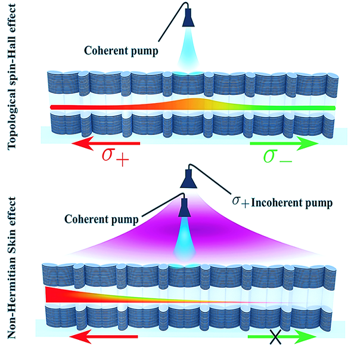
To implement these concepts we employ potentials imprinted into optical microcavities (see figure above), which allow to spatially trap polaritons and emulate artificial atoms that can emulate designed Hamiltonians.

Thanks to patterned optical microcavities, and based on lead halide perovskites, we have implemented a polariton lattice (figure (a)), successfully reproducing the Su-Schriefeer-Heeger topology at room-temperature, illustrated by the presence of edge-states within the bandgap (Figure (b)) localized at the limit of the lattice (Figure (c)).
We work on theoretically designing and modelling mechanism of non-reciprocal transport in polariton lattices, by making use of non-Hermitian topological concepts. We also conceive physical mechanism enabling spin separation and polariton flux generation even at normal incidence (see figure on the left). These mechanisms could play a role in schemes of circuits, networks, and other information processing schemes with exciton-polaritons.
To implement these concepts we employ potentials imprinted into optical microcavities (see figure below), which allow to spatially trap polaritons and emulate artificial atoms that can emulate designed Hamiltonians.
“Realizing active topological polaritonic devices working at ambient conditions and emulating complex Hamiltonians”
- S. Mandal, R. Banerjee, and T. C. H. Liew, “From the topological spin-Hall effect to the non-Hermitian skin effect in an elliptical micropillar chain ”, ACS Photon. 9, 527 (2022).
- R. Su, S. Gosh, T. C. H. Liew, and Q. Xiong, “Optical switching of topological phase in a perovskite polariton lattice”, Sci. Adv. 7, 8049 (2021).
Nonlinear cavities
(Alexia AUFFEVES, Weibo GAO, Tim LIEW, Maxime RICHARD, Rui SU, Jesus ZUNIGA-PEREZ)
We engineer strong interactions between photons in solid-state photonic resonators via Kerr like nonlinearity and investigate the resulting many-body quantum states to address fundamental questions and applications.
Two-body and many-body interactions within a quantum fluid generates quantum states at the few particle level such as pair quantum correlations and entanglement, and at the macroscopic level with quantum phenomena such as superfluidity, and quantum turbulence. In a quantum fluid of light, these quantum resources are naturally coupled to free propagating photons, a feature that provides a convenient interface for in-depth investigation and collection/propagation of the generated quantum resources.
“By enhancing the optomechanical interaction within an optical microcavity containing electronic excitations, we will couple the mechanical degree of freedom with the nonclassical light generated in situ.”
We work on demonstrating parametric nonlinear optical processes in a WS2microcavity, pumped at the inflection point and triggered in the ground stateare, processes that are at the heart of nonlinear optics for the generation of entangled photons as well as the realization of coherent optical sources.
- P. Stepanov, A. Vashisht, M. Klaas, N. Lundt, S. Tongay, M. Blei, S. Höfling, T. Volz, A. Minguzzi, J. Renard, C. Schneider, and M. Richard , “Exciton-exciton interaction beyond the hydrogenic picture in a MoSe2 monolayer in the strong light-matter coupling regime”, Phys. Rev. Lett. 126, 167401 (2021)
- J. Zhao, A. Fieramosca, R. Bao, W. Du, K. Dini, R. Su, J. Feng, Y. Luo, D. Sanvitto, T. C. H. Liew, and Q. Xiong, “Nonlinear polariton parametric emission in an atomically thin semiconductor based microcavity»”, Nature Nanotech. 17, 396 (2022)
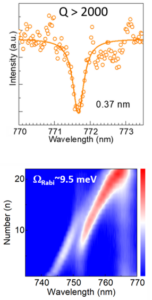
Reflectivity measurement demonstrating a Q>2000 (top) and anticrossing illustrating the strong-coupling between excitons in TMDs and photons in the cavity (bottom).
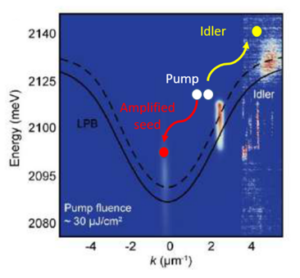
Energy versus in-plane momentum reflectivity map at high (~ 30 μJ/cm2 ) pump fluence.
Circuit quantum eletrodynamics & quantum networks
(Alexia AUFFEVES, Yvonne GAO, Weibo GAO, Leong C. KWEK, Steven TOUZARD, Jesus ZUNIGA-PEREZ)
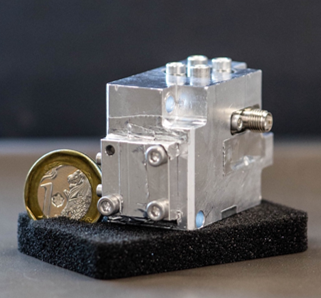
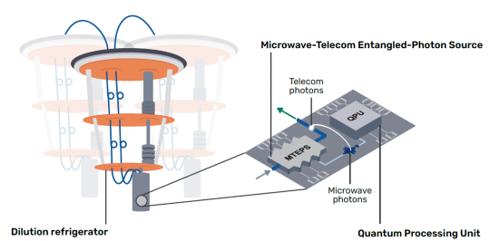
Sketch of the telecom photons/superconducting circuits entanglement protocol.
The development of quantum networks requires the implementation of modular quantum devices as well as the communication and secure linking between them.
Our contributions rely on the implementation and characterization of microwave photons interacting with “artificial atoms” (see figure in the left), and the use of bosonic quantum elements for information encoding and processing. Thanks to these architectures, we will further engineer the nonlinearities and study their effect in the dynamics of the fabricated circuits.
The communication between separated superconducting circuits will be carried out thanks to the use of telecommunication photons and the implementation of an entanglement protocol between the telecom photons and the superconducting circuits (see Figure below). The designed protocol bypasses the requirement for general purpose frequency conversion, which could speed-up the establishment of large-scale quantum networks as well as city-level ones, as ambitioned by Singapore.
- M. Meunier, J. J. H. Eng, Z. Mu, S. Chenot, V. Brändli, P. de Mierry, W. Gao, and J. Zúñiga-Pérez, “Telecom single-photon emitters in GaN operating at room temperature: embedment into bullseye antennas”Nanophotonics, 2023.https://doi.org/10.1515/nanoph-2022-0659
Keywords: Quantum fluids of light, polaritons, quantum optomechanics, trapped single atoms, ultracold gases, single-photon devices, superconducting qubits and architectures, integrated photonics, quantum sensors
